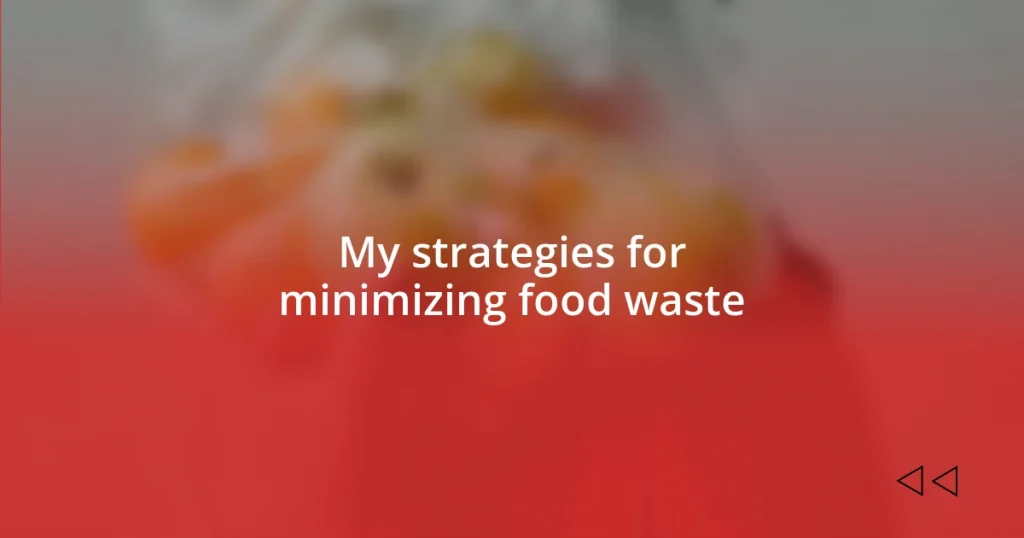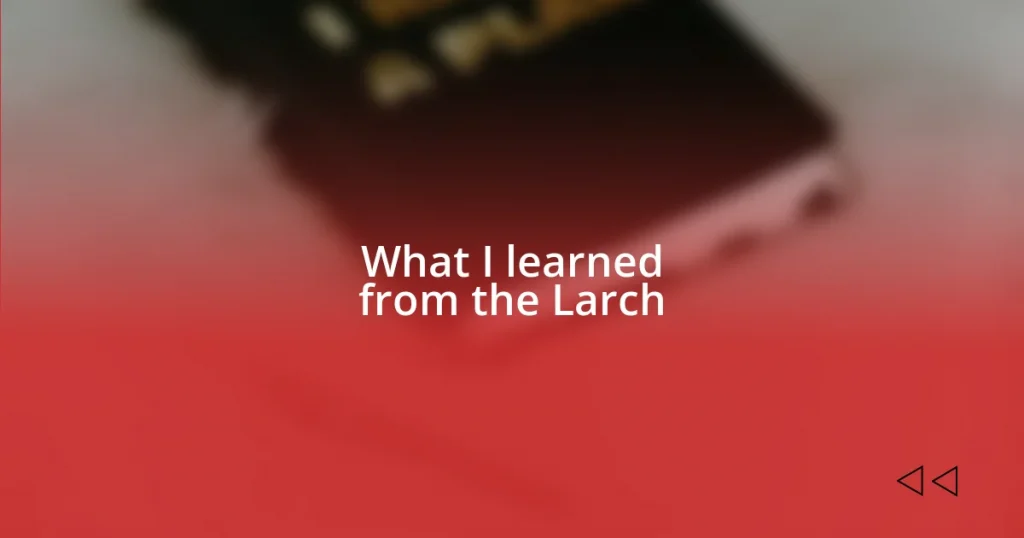Key takeaways:
- One-third of global food production is wasted, emphasizing the need for awareness and better meal planning to minimize waste.
- Effective meal planning and grocery shopping techniques, such as organized lists and seasonal purchases, significantly reduce impulse buys and promote healthier eating.
- Innovative food storage methods, creative use of leftovers, and composting enhance sustainability and reduce food waste in household kitchens.
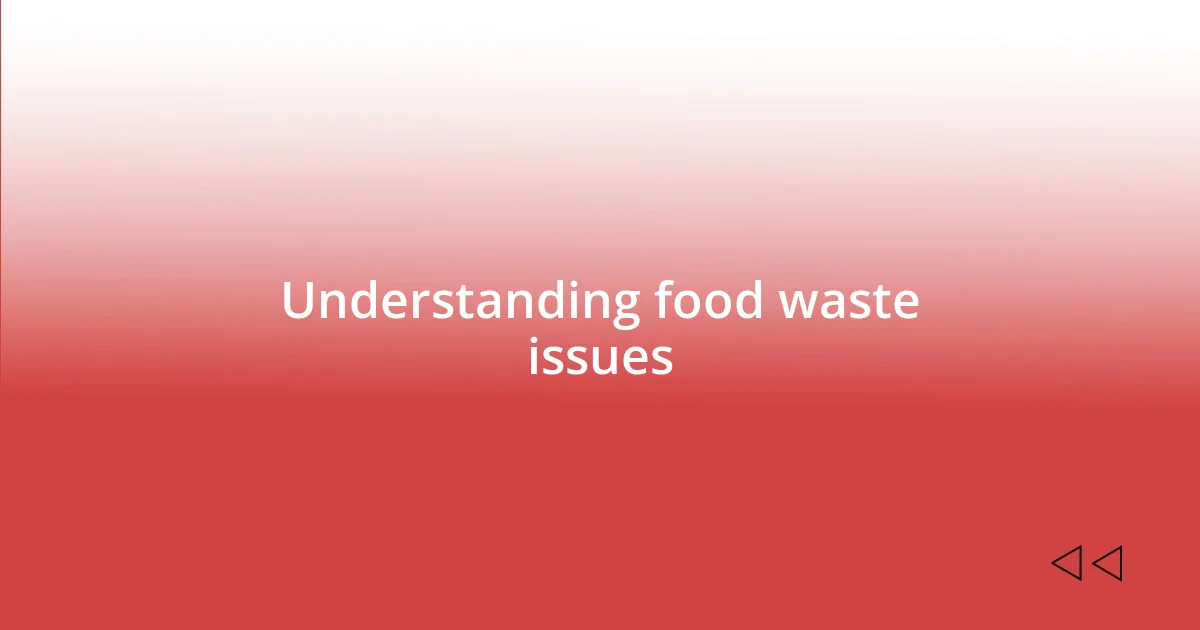
Understanding food waste issues
As I reflect on my own experiences in meal planning, it’s staggering to think about how much food gets wasted globally—about one-third of all food produced. I remember the times I’d buy fresh produce with the best intentions, only to see half of it rot in my fridge. Isn’t it disheartening to think that while so many people go hungry, perfectly good food ends up in landfills?
It’s not just about the food itself; the implications of food waste stretch far beyond our kitchens. When we discard food, we’re also wasting the water, labor, and resources that went into producing it. Imagine the joy of savoring every bite of that meal instead! Isn’t it frustrating to consider the energy wasted when so many individuals, like ourselves, strive for a more sustainable future?
One thing that stands out to me is how food waste often comes down to a lack of awareness. I used to think that food simply expired on its own, but now I understand more about expiration dates and how they can be misleading. Have you ever noticed how that yogurt in the back of your fridge, while past its “sell by” date, is still perfectly good? Learning to distinguish between these labels can not only reduce waste but save you money and encourage greater mindfulness about our food choices.
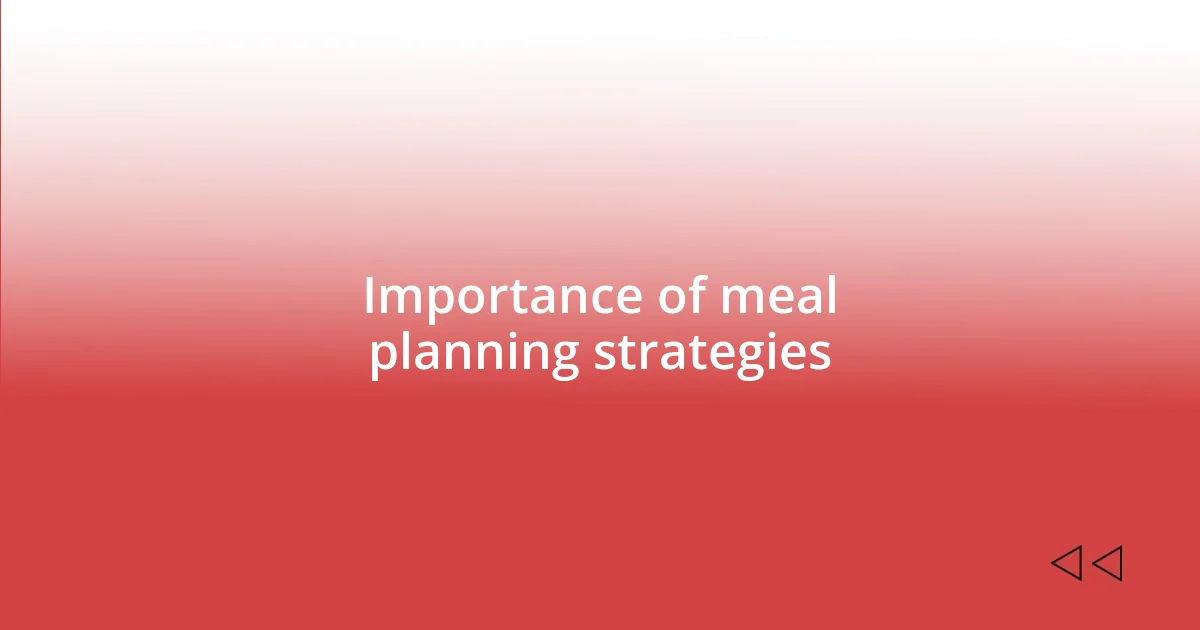
Importance of meal planning strategies
Meal planning strategies hold significant importance in our effort to minimize food waste and simplify our cooking experiences. When I first began planning my meals in advance, I noticed a substantial reduction in the food I had to throw away. Instead of aimlessly perusing the grocery aisles, I found that having a list made me more intentional about what I bought. This shift not only kept my fridge organized but also allowed me to use every ingredient I purchased, transforming my cooking into a rewarding experience rather than a dreaded chore.
Here are a few key benefits of effective meal planning:
- Reduces impulse purchases: A well-crafted shopping list can minimize unnecessary buys that often end up spoiled.
- Saves time and stress: Knowing what you’ll be cooking each day simplifies meal prep and cuts down on last-minute decisions.
- Encourages creativity: Planning meals can inspire you to try new recipes and use ingredients in innovative ways.
- Promotes nutritional balance: Thoughtfully planning meals can help ensure a variety of nutrients in your diet, making it healthier overall.
I fondly recall a time I discovered a unique recipe that utilized all the vegetables I had left over from the previous week. Instead of letting them languish in the crisper drawer, I transformed them into a hearty soup that not only cleared out the fridge but also warmed my soul on a chilly day. That moment reinforced how meal planning isn’t just a task, but a creative outlet that fosters sustainability and reduces waste.
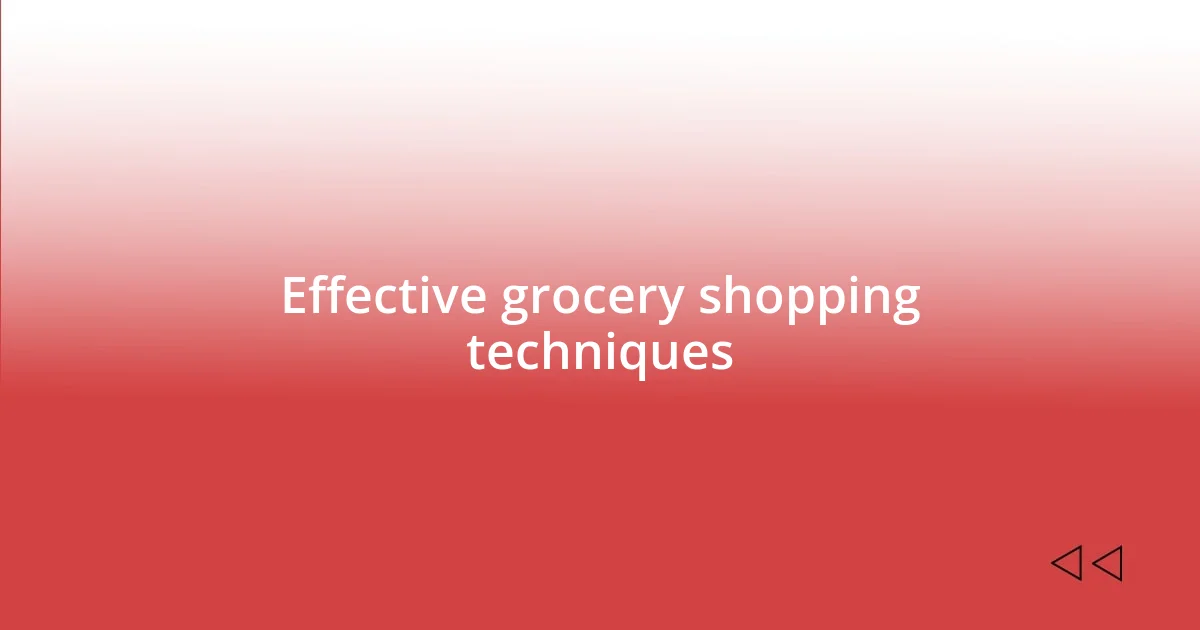
Effective grocery shopping techniques
When it comes to effective grocery shopping techniques, organization is key. I’ve found that grouping similar items together on my shopping list helps ensure I don’t forget anything and minimizes backtracking in the store. This not only saves time but also keeps me focused, reducing the temptation to toss in unnecessary items that might go to waste later.
Another technique I’ve discovered is the importance of shopping the perimeter of the grocery store. Most fresh produce, dairy, and lean proteins are located around the edges, while the center aisles tend to house processed foods. For me, spending more time on the perimeter has allowed me to focus on healthier options that have a longer shelf life when prepared correctly. Have you ever noticed how many tempting snacks are tucked away in the aisles? It takes discipline, but my fridge has never looked better since I shifted my shopping habits.
Lastly, I’ve realized that shopping seasonally not only enhances the taste of my meals but helps reduce waste significantly. Seasonal produce is often cheaper and fresher, making it easier to plan meals around what’s available. When I buy ripe tomatoes in summer, I know I can use them quickly in salads or sauces before they spoil. Contrast that with buying out-of-season tomatoes, which generally sit in the fridge and quickly lose flavor or turn bad. It truly is a game-changer to get in sync with nature’s schedule.
| Shopping Technique | Benefits |
|---|---|
| Organized Shopping Lists | Reduces impulse purchases and saves time. |
| Shopping Perimeter | Focuses on fresher, healthier options. |
| Buying Seasonal Produce | Enhances flavor and minimizes spoilage. |
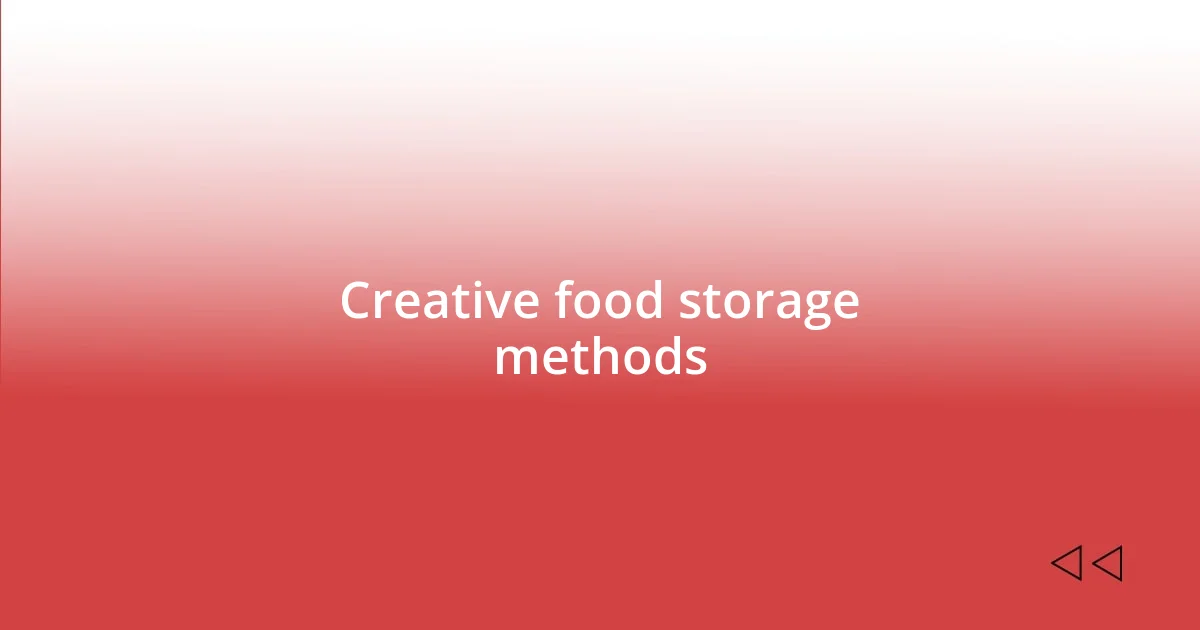
Creative food storage methods
I’ve found that creative food storage methods can truly extend the life of your groceries while adding a touch of fun to your kitchen routine. For instance, using glass jars not only looks aesthetically pleasing but also helps you see what you have at a glance. I remember experimenting with this when I transferred my grains and nuts into colorful jars; not only did my pantry feel more organized, but I also discovered I had forgotten about some ingredients that could spark new culinary adventures.
I also discovered that freezing not just whole meals, but individual ingredients, can make cooking much more flexible. When I had an abundance of ripe bananas, instead of letting them brown away, I peeled and froze them for smoothies. Isn’t it satisfying to know you can grab a handful of prepped ingredients whenever inspiration strikes? It feels like having a secret weapon in the freezer, just waiting to turn into something delicious!
Another method I’ve come to love is using airtight containers for leftovers. This simple step has transformed my approach to meals. I recall a night when I made a pasta dish that tasted even better the next day. When I stored the leftovers in clear containers, not only did I remember to eat them, but I also savored the memory of that meal each time I opened the fridge. Have you ever forgotten about leftovers because they didn’t catch your eye? Proper storage can change that!
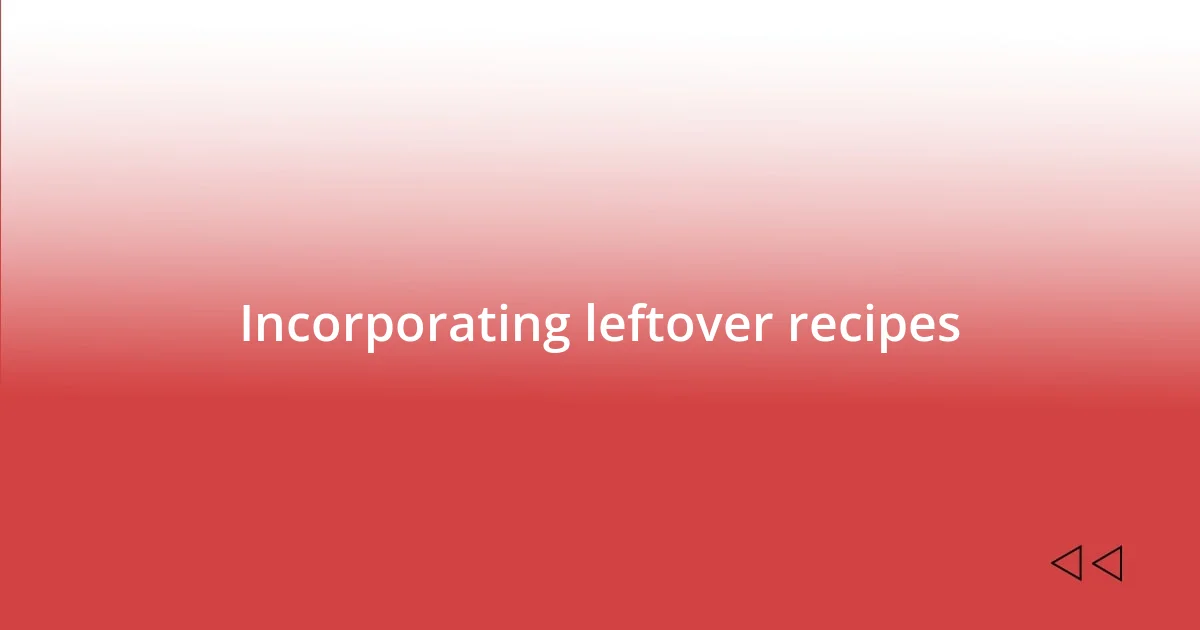
Incorporating leftover recipes
Incorporating leftover recipes is one of the most rewarding strategies I’ve adopted in my kitchen. I remember a particularly busy week when I had leftover roasted chicken, and instead of letting it languish in the fridge, I whipped up a comforting chicken soup. The tender pieces of chicken combined with fresh veggies and broth transformed what could have been wasted food into a delightful meal that warmed both my belly and my heart. Have you ever felt that thrill of turning scraps into something delicious?
One trick I love is to take a look at what I have before meal planning each week. I’ve found that when I assess my leftovers creatively, I not only minimize waste but often stumble upon some of the best culinary adventures. For example, that same week, I discovered a half can of coconut milk lingering in the back of the fridge. It found its way into a curry dish with old vegetables, and I was pleasantly surprised by the explosion of flavors. Isn’t it amazing how leftovers can spark our creativity in the kitchen?
Additionally, I enjoy sharing these leftover creations with friends and family. Just last month, I hosted a small get-together and used leftover roasted veggies to make a delicious frittata. The way my friends savored every bite reminded me that food truly brings people together. Instead of feeling like leftovers were a burden, I felt a sense of joy seeing others enjoy what I’d made. What better way to celebrate leftover recipes than by turning them into a shared experience?
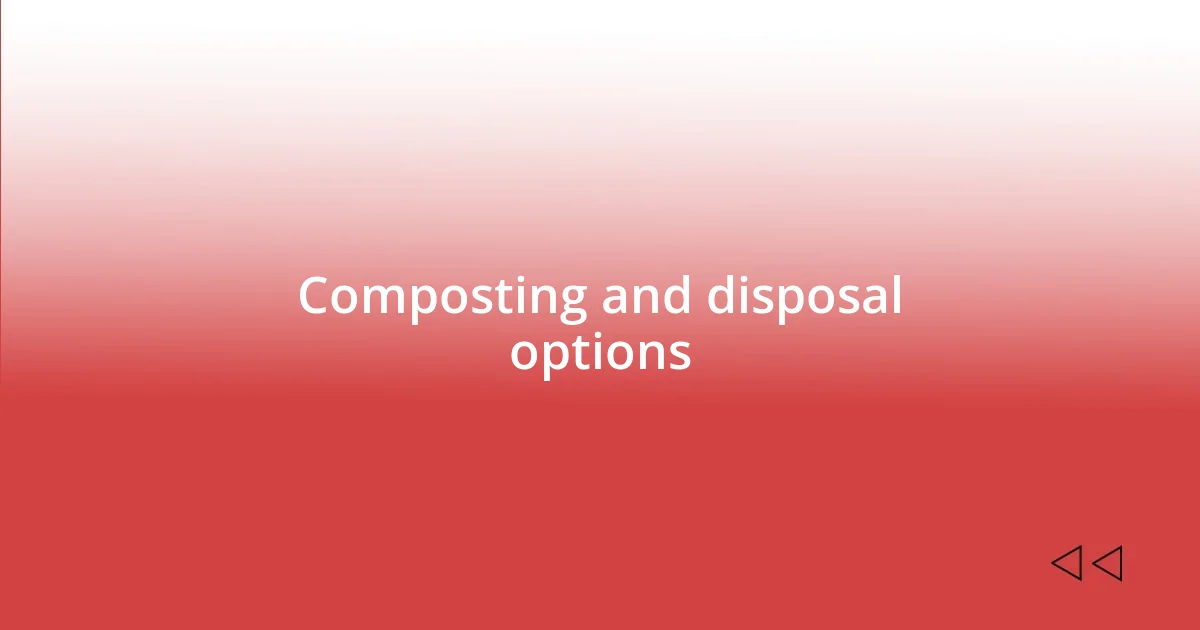
Composting and disposal options
Composting offers a wonderful way to turn food scraps into something beneficial for your garden. I remember the first time I set up my compost bin; it felt rewarding to see leftover vegetable peels and coffee grounds transform into rich compost. It’s like giving back to the earth, knowing those scraps will nourish future plants. Have you ever thought about how much you could enrich your garden with what you usually throw away?
When it comes to disposal options, it’s essential to consider local guidelines. I’ve always made it a habit to check what can be composted or recycled in my area. Once, I was surprised to learn that paper towels, which I often used for food prep, could actually go into my compost pile. This little tweak in my routine allowed me to reduce waste significantly while still maintaining cleanliness in my kitchen.
Not every food waste is suitable for composting, though. I once faced a dilemma with old pizza boxes; I learned the greasy ones could not be composted. Instead, I took the time to separate the recyclable parts, which made me more mindful about packaging in the future. Isn’t it fascinating how making small adjustments can help you manage waste better and lead to a more sustainable lifestyle?










